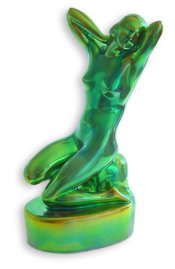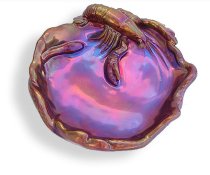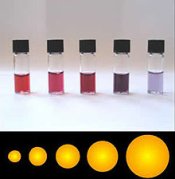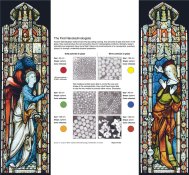AÇIKLAMA
[0001] The present invention relates to new and improved liquid gold compositions, a method of preparation therefor and use thereof for decorating substrates.
[0002] Liquid gold compositions have been known in the art and used for gilding and decorating substrates for a long time. Traditional liquid gold compositions contain gold sulpho-resinates in combination with natural resinous materials (by Boudnikoff, Compt. Rend., 196, 1898 (1933) and by Chemnitius, J. Prakt. Chem., 117, 245 (1927)). The gold sulpho-resinates are prepared by the reaction of a gold chloride solution with a sulphurised terpene. These are then diluted with natural oils such as lavender, rosemary and pine oils. Rosin and asphalt resins are added to thicken the compositions so that they are suitable for decorating, gilding or printing applications. Furthermore, small amounts of salts or resinates of metals such as rhodium, bismuth, chromium etc are also added as fluxes to these compositions to improve the lustre of the gold in the fired product and also to improve the adhesion of the gold applied to the substrate upon firing. In preparing other compositions, various gold mercaptides have been used. For instance, US-A-2490399 describes the use of gold mercaptides of cyclic terpenes but does not provide any structure for the resultant mercaptide. Again, the mercaptide of gold prepared from thio-borneol has been described in the Journal of the Society of the Chemical Industry, Japan, 38, Supplement 617B (1935) by Nakatsuchi although this reference makes no mention of the possibility of using such compounds in decorating or gilding compositions. According to US-A-3163665, the gold thiolates derived from cyclic terpenes have the disadvantage of requiring relatively high firing temperatures, thereby limiting their use on substrates such as glass, ceramics etc. and consequently recommends the use of non-terpenoid gold secondary mercaptides. Similarly, US-A-3245809 claims and describes the use of a liquid gold decorating composition comprising a nuclear-substituted gold aryl mercaptide wherein the sulphur is attached directly to the aryl nucleus which is already substituted by an alkyl group in solution in an organic vehicle and a gold flux. The specific aryl mercaptides disclosed include gold p-tert.-butylphenyl mercaptide prepared from p-tert.-butylbenzenethiol and aurous chloride. The fluxes used are said to contain small amounts of salts or resinates of rhodium or iridium to improve the continuity and brilliance of the gold film and the only other component, apart from the vehicle (solvent), is rosin dissolved in oil of turpentine. No synthetic polymeric thickeners are mentioned in these compositions.
[0003] More recently, US-A-5328769 states that the conventional isooctyl- and tert.-dodecyl-gold thioglycolates are not satisfactory for use in gilding preparations for decorating ceramics because the drying time for such preparations is very long. This document also states that gold (I) bornyl mercaptide (described in US-A-4221826) proved advantageous in the production of integrated electronic circuits but that such compounds "have the disadvantage of a partially very unpleasant odour which becomes particularly noticeable in a disturbing manner when the gold preparations are applied by heat". Thus, instead, this reference claims and describes a method of gilding solid bases, by applying a gold preparation comprising a gold mercaptocarboxylic acid ester on to a solid base followed by firing. The "gold preparation" also contains fluxing agents including in particular, sulphoresinates, resinates, naphthenates, carboxylates, and dithiocarbamates of the elements B, Si, V, Cr, In, Sn, Pb, Bi and Rh. These compositions are also stated to contain one or several resins from the series of wood resins and synthetic resins (e.g., hydrocarbon resins, polyacrylates and polymethacrylates). However, no preparations containing these synthetic resins are described and no particular benefit or advantage is said to accrue by the use of such synthetic resins.
[0004] Thus, the liquid gold compositions typically involve the use of either (i) a gold mercaptide compound, or, (ii) a gold sulpho-resinate, in combination with natural resins (e.g. rosin or colophony, often in their sulphided form, or, asphalt) and some synthetic resins such as e.g. phenol-aldehyde resins. The gold sulpho-resinates of the present invention in turn can be obtained from a gold (III) compound or gold (I) salts or compounds and a sulphurised terpene, the terpene component of which may be naturally occuring. These compositions may have overcome some of the traditional problems such as e.g. adhesion, drying, odour etc. However, they still have one or more of the following disadvantages:
[0005] Unsatisfactory application of ink onto substrate; undesirable changes in viscosity during application; formation of defective films on application to the substrate prior to firing; dewetting of ink on substrate (often caused by sensitivity of ink to dust particles) leading to pinholing; formation of defective films having 'black spots' on firing which cannot be envisioned prior to firing; poor adhesion of the gold film on to the substrate; and observation of poor colour, usually red, on the reverse of transparent substrates such as e.g. glass.
[0006] It has now been found that the performance of the liquid gold compositions in all the above aspects can be substantially improved by choice of a specific synthetic polymer for thickening such compositions.
[0007] Accordingly, the present invention is a liquid gold composition comprising a gold lustre and an effective amount of an acrylate polymer of the formula:
where
R = H or a C1-C4 alkyl group,
Y = a C5 - C40 hydrocarbyl group, which is monocyclic, bicyclic or tricyclic, which may be further carry ring substituents. and
n = an integer representing the number of repeat units in the polymer.
[0008] By the expression "gold lustre" as used herein and throughout the specification is meant a derivative of gold which may be a sulpho-resinate, hydrocarbyl (such as e.g. alkyl or aryl) mercaptide, or a mercaptocarboxylic acid or an ester thereof. The term gold sulpho-resinate in the context of the present invention means a gold compound formed from a gold (III) compound or a gold (I) compound and sulphurised resin group. As mentioned previously, the gold sulpho-resinates can be obtained from a gold (III) salt and a sulphurised terpene, the terpene component of which may be naturally occuring. Specific examples of such mercaptide compounds include:
a. hydrocarbyl gold mercaptides of the formulae Au-S-CH2R1, wherein R1 = alkyl
Au-S-CH(R2)R3, wherein each of R 2 and R3 = the same or different alkyl or aryl group (secondary thiols)
Au-S-CR4R5 R6, wherein each of R4, R5 and R 6 = the same or different alkyl or aryl group (tertiary thiols)
Au-S-R7 wherein R7 = aryl group or a substituted aryl group (aromatic thiols).
Au-SCHR-C02R' where R = H, alkyl, aryl and R' =H, alkyl, aryl
[0009] More specifically, references to the hydrocarbyl groups, such as e.g. alkyl or aryl groups, in the formulae above includes within its scope the respective groups selected from alkyl, cycloalkyl, aryl and aralkyl groups, and any substituted derivatives thereof. For example the substitued derivitives may be halo, amino, carboxylic acid or ester groups. Specifically, the hydrocarbyl groups in the mercaptide may be any one of methyl, ethyl, isopropyl, butyl, sec.-butyl, isobutyl, tert-butyl, heptyl. octyl, isooctyl, 2-ethyl hexyl, di-isobutylmethyl, nonyl, tert-nonyl, decyl, tert-decyl, undecyl, tert-undecyl, dodecyl, tert-dodecyl, tridecyl and octadecyl, cyclobutyl, cyclopentyl, cyclohexyl, dicyclohexylmethyl, phenyl, naphthyl, phenanthryl, benzyl, methylphenyl, 2-phenyl ethyl, 4-phenyl butyl, p-tert.-butylphenyl, o-methyl-p-tert.-butylphenyl, pinanyl, mixed methylphenyl, mixed dimethylphenyl, mixed dibenzylmethyl, p-chlorophenyl, pentachlorophenyl, o-carboxy-phenyl and o-aminophenyl groups. These mercaptides can be prepared by admixing the appropriate hydrocarbyl mercaptan with a gold salt suitably a halogenated auric salt such as auric bromide. auric chloride. auric iodide, potassium bromoaurate or potassium iodoaurate as described in US-A-3245809.
[0010] The acrylate polymers present in the compositions of the present invention are of the formula:
where
R = H or a C1-C4 alkyl group,
Y = a C5 - C40 hydrocarbyl group, which is monocyclic, bicyclic or tricyclic and which may be further carry ring substituents, and
n = an integer representing the number of repeat units in the polymer.
[0011] Cyclic hydrocarbyl groups representing Y are suitably terpenyl groups derivable from a terpene and the term "terpene" as used herein and throughout the specification is meant to describe a cyclic compound which is a natural, non-aromatic constituent of an essential oil, containing carbon, hydrogen and optionally oxygen, and/or synthetic compounds which are very closely related to these natural terpenes. These terpenes can be selected from the following classes based on the number of isoprene units within the structure: monoterpenes (10 carbons - two isoprene units), sesquiterpenes (15 carbons), diterpenes (20 carbons), triterpenes (30 carbons) and tetraterpenes (40 carbons). Of these. the group Y is preferably a terpenyl group derived from a bicyclic monoterpene (10 carbons). More specifically, examples of bicyclic monoterpenyl groups include bornyl, isobornyl, thujyl, fenchyl, pinocamphyl and isopinocamphyl groups.
[0012] Such polymers can be prepared by solution or suspension polymerisation reaction of the desired monomer and a suitable initiator under dry anaerobic reaction conditions. The polymers of formula (I) suitably have an average molecular weight in the range from 2.000 to 600,000, preferably from 30,000 to 600,000, more preferably from 50,000 to 200,000.
[0013] An example of a polymer of formula (I) is poly(isobornyl methacrylate) which in turn can be made from the corresponding isobornyl methacrylate monomer and having an average molecular weight in the range from 500,000-600,000. Such polymers are commercially available (ex Aldrich Chemicals).
[0014] The amount of the polymer (I) in the compositions of the present invention is suitably in the range from 0.05 to 50% by weight, preferably from 0.5 to 30% by weight, typically 1 to 10% by weight of the total composition. The amount of the polymer (I) used may vary within these ranges depending upon the molecular weight thereof and the method used for the application of the liquid gold composition on the substrate.
[0015] The compositions of the present invention suitably contain in addition a solvent to provide a vehicle for applying the gold composition onto a substrate. The solvent should be such that it is capable of forming a substantially homogeneous mixture with the gold lustre and the polymer so as to form a liquid or a smooth paste. Thus, the solvent chosen should be such that it is commensurate with the desired physical properties in the composition such as e.g. oilness, viscosity, evaporation rate, surface tension and tack, depending upon the manner in which the composition is to be applied to the substrate surface. Suitable examples of such solvents include ketones, aliphatic hydrocarbons, aromatic hydrocarbons. alkyl acetates, glycol ethers, terpenes, natural oils and waxes. More specifically, these may be one or more of the following: methyl ethyl ketone, cyclohexanone, ethyl acetate, ethyl lactate, butyl lactate, amyl acetate, cellosolve, butanol, cyclohexanol, propylene glycol butyl ether, propylene glycol phenyl ether, dipropylene glycol dimethyl ether, propylene glycol methyl ether acetate, toluene, xylene. petroleum ether, terpenes such as pinene, dipentene, dipentene oxide, natural oils such as lavender, rosemary, aniseed, sassafras, wintergreen, fennel, and turpentine. Various other subsidiary resins such as rosin, asphalt, colophony, poly(terpene), phenolformaldehyde resins and the like may also be present in the compositions of the present invention.
[0016] The compositions of the present invention may contain in addition gold fluxes which are small amounts of metal salts or resinates and these determine the behaviour of the gold film during application on the substrate and subsequent firing thereof at elevated temperature. The specific choice of flux will be determined not only by the aforementioned conditions but also by the substrate upon which the composition is to be applied, the method of application as well as the need to provide lustre to the metal film applied on the substrate. Examples of fluxes that may be used include salts or resinates of antimony, bismuth, boron, cadmium, cerium, chromium, cobalt, copper, iridium, lead, rhodium, silicon, silver, tin, titanium, vanadium and zirconium. The fluxes also improve the adhesion of the gold metal film on the substrate and provide resistance to abrasion. The fluxes achieve these functions by initially melting and then forming a thin, protective, transparent film on the metal film during the firing process. Of these, fluxes containing salts or resinates of rhodium and/or iridium are most preferred.
[0017] The amount of flux added to the compositions of the present invention is suitably in the range from about 0.01 to 10 % by weight, preferably from about 0.05 to 5.0 % by weight of the total composition.
[0018] The substrate surface on which the compositions of the present invention are applied may be suitably of relatively refractory materials and are preferably selected from the group consisting of glass, earthenware, bone china, porcelain, silicate materials, metals, quartz, carbon, mica and the like.
[0019] The compositions of the present invention may be applied on the substrates by any of the known application methods. For instance, they may be applied by simple brush coating, spraying, stippling, stenciling, decalomania, direct and offset printing, indirect screen-printing, direct hot- or cold-printing or ink-jet printing techniques.
[0020] Thus, according to a further embodiment the present invention is a method of decorating substrate surfaces, said method comprising applying a composition comprising a gold lustre and the polymer (I) in a solvent, and heat-treating the resultant substrate to cure the decoration on the substrate surface.
[0021] As indicated above, once the composition of the present invention in a solvent is applied as a decoration on a substrate surface, the decoration is suitably cured by heat-treating the decorated substrate at elevated temperature. The heat-treatment temperatures used will depend upon the nature of the gold lustre used, the solvent used and the amount of the polymer (I) used, although more importantly, it will depend upon the substrate surface upon which the decoration is applied. Thus, for refractory substrates, heat-treatment/firing temperatures may vary over a wide range from about 300-1300C, preferably from about 500-900C, typically from about 550-900C. Temperatures towards the upper end of the ranges specified above e.g. around 900C may be required for substrates such as porcelain.
[0022] A feature of the compositions of the present invention is that the use of the specific polymers (I) showed excellent compatibility with the gold lustres used. Moreover, on firing, the major problem of 'black spot' formation with conventional compositions was no longer observed. Also, on glass, reverse colour is improved over that of currently available compositions for this purpose. Analogous formulations prepared using commercially available polymers corresponding to polymer (I) but in, which the terpenyl group Y is replaced by a relatively simple alkyl group, such as eg methyl, ethyl or butyl groups, did not show similar improvement in the decorative films formed.
[0023] The compositions and process of the present invention are further illustrated with reference to the following Examples:
EXAMPLES:
Bright gold preparations
[0024] All composition data is in % by weight and all firing temperatures are in C. The gold sulpho-resinates used are available from Johnson Matthey PLC and the silver sulpho-resinates were prepared from silver and sulphurised balsam. A solution of poly(isobomyl methacrylate) was prepared in the stated solvent at various concentrations as specified in each Example below. All formulations were prepared to give 'a concentration of 10% wt Au. This was then used to prepare the following liquid gold formulations. All formulations were prepared to give a concentration of 10wt%Au.
EXAMPLE 1
[0025]
18.3 Au(SC6H4-p-CMe3) (prepared according to the method described in US-A-3,245,809)
40 Poly(isobornyl methacrylate) (ex Aldrich. MW 550.000) as a 30% by weight solution in cyclohexanone
4 Rh-ethyl-hexanoate dissolved in cyclohexanone (0.12% Rh)
37.7 Xylene
100
Comparative Test
(not according to the invention):
[0026]
18.3 Au(SC6H4-p-CMe3) (prepared according to the method described in Example 1(F) of US-A-3,245,809)
40 Poly(butyl methacrylate) (NeocrylB804, ex Zeneca Resins) as a 30% by weight solution in cyclohexanone
4 Rh-ethyl-hexanoate dissolved in cyclohexanone (0.12% Rh)
37.7 Xylene
100
[0027] Each of the above two formulations were gilded onto ceramic ware, and fired at 865C over a 1 hour cycle. The formulation of Example 1 gave bright golden films free of film defects whereas the formulation of the Comparative Test gave poor quality films.
EXAMPLE 2
[0028]
30.86 Gold sulpho-resinate
40 Poly(isobornyl methacrylate) (ex Aldrich Chemicals) as a 20% by weight solution in cyclohexanone
4 Rh-ethyl-hexanoate dissolved in cyclohexanone to a final concentration of 3% Rh
0.54 Cr Nuosyn5 to a final concentration of 7.45% Cr2O3
3.67 Bismuth octoate lustre to a concentration of 10% Bi2O3
20.93 Rosemary oil
100
[0029] The formulation was applied to china and porcelain by brush over a large area. Upon firing, it gave a bright gold film of similar colour to commercial golds with no film defects (ie black spots) observed in the film.
EXAMPLE 3
[0030] The process of Example 2 was repeated except that sulphided colophony resin was used instead of the poly(isobomyl methacrylate). Bright films, with film defects were obtained upon application and subsequent firing.
EXAMPLE 4
[0031]
18.3 Au(SC6H4-p-CMe3)
29.9 -pinene
21.2 Silver sulpho-resinate solution (2% wt Ag) in form
2.4 Anethol
1.2 Rosemary oil
10 Dipentene
10 Poly(isobornyl methacrylate) as a 20% wt cyclohexanone solution
6 Poly(isobomyl methacrylate) as a 20% wt solution in lavender oil
1 Rh-ethyl-hexanoate dissolved in cyclohexanone (0.12% Rh)
[0032] The formulation was applied onto a Koelner Stange glass at 580C and upon firing bright films free of film defects were obtained.
EXAMPLE 5
[0033]
18.3 AuSC6H4-p-CMe3
40 30% wt Poly(isobornyl methacrylate) (100,000 mwt supplied by Scientific Polymer Products Inc.) solution in cyclohexanone
4 Rh-hexanoate dissolved in cyclohexanone (0.12%Rh)
37.7 Xylene
[0034] The formulation above was gilded onto ceramic ware , fired at 840°C over 1hr. Bright gold films free of defects were produced.



















